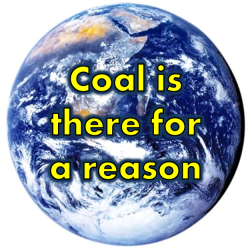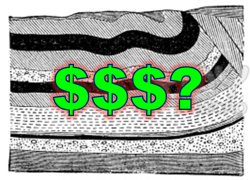Dave Roberts and others have been talking about leaving coal in the ground. That got me thinking: What’s it worth there?
The question looms large in light of recent and imminent federal leases to extract a bazillion tons of coal from public land in the Powder River Basin (PRB). Critics of the practice note that Americans are being compensated for this public resource at well below its market value.
But if you don’t happen to be in the coal business, the market value of coal-to-burn pales in comparison to the vital functions of coal-in-the-ground (hereafter, “coal ITG”).
Undisturbed coal delivers enormous benefits, like long-term strategic resource security, and locking up mercury that otherwise floats around causing neurological disorders. And the greatest value of coal ITG may be in the carbon it stores. That carbon was once in the atmosphere, as a result of which the Earth was a sauna with much higher sea levels.
What’s it worth to continue living on Earth as it is, rather than in, say, Jurassic Park? The value in the absence of large predatory reptiles alone is incalculable!
How might we estimate the value of coal ITG? Bona fide wonks should respond. But I’m going to take a quick hack at it, because the Bureau of Land Management is leasing the coal now. We need to assess whether the lease revenues fully compensate Americans for the lost value of the coal ITG.
Determining this value raises tricky questions about how a unit of coal might be kept in the ground, and whether doing so would actually keep the equivalent greenhouse gases out of the atmosphere (“leakage effects,” etc.) But let’s suspend those questions for a moment and assume that coal ITG is carbon that’s not warming the climate. Because, you know, physically, it is.
One way to think about what coal is worth in the ground would be to assess how much it costs us once it gets out and gets burned. EPA did just that in its regulatory impact analysis for new greenhouse gas standards. They estimate the social cost of carbon dioxide at $24 per ton in 2015, escalating to $45 per ton in 2050 (using a 3% discount rate.) Let’s take the middle of that range, since these coal leases go out for decades, and use $35 per ton of CO2. Figure a ton of PRB coal produces 1.8 tons of CO2, so the carbon storage value of a ton in the ground would be north of $60.
You can imagine other ways of assessing the value, for example, by looking at:
– Economic damages due to climate disruption, as the Stern Review did. Divide the total damages by the amount of GHGs assumed to be released, and you can derive an associated value for coal ITG. If you do it this way, you really ought to include the huge health costs of burning coal, as the Harvard School of Public Health did when they estimated external costs of burning coal for electricity in the U.S. at $175-523 billion a year. We burn a billionish tons a year in the U.S. Since PRB coal is relatively low in sulfur and ash, it’d be worth a little less than $175-523 per ton – in the ground – using this method.
– Carbon markets: If CO2 allowances were traded in a market that limited total emissions to levels consistent with responsible climate stabilization, how much would they go for? Synapse did an analysis that came up with a mid-range $26 per ton of CO2. Again, a ton of PRB coal produces 1.8 tons of CO2 when burned, so this gives us a carbon storage value of coal ITG of $46.80. (This is conservative, since assumed carbon caps are too high to prevent catastrophic climate disruption.)
– Sequestration costs: What if we can’t help ourselves — what if we just have to burn that coal and release the CO2? What would it cost to put it back, permanently and reliably? A Belfer Center study estimated the cost of first generation carbon capture and storage technology at $120-$180 per ton of CO2 avoided. Again, multiply by 1.8 to get the value per ton of PRB coal ITG.
I’m obviously only scratching the surface with a cooked noodle here; we can wonk around with this all day (and I do hope better wonks will). But quickly, before BLM squanders more of our coal ITG, let’s just use the official social cost of CO2 ($35 ton, cited above and here) as our proxy, and multiply by 1.8 for PRB coal: So, say the coal ITG is worth more than $60 per ton in carbon storage alone.
Now… Where does BLM get OFF selling that $60 a ton public coal ITG for $1.11 a ton (the price of the most recent federal lease)? Their primary justification appears to be that it helps Americans get cheap electricity. But the external costs cited in the Harvard School of Public Health study at least double the cost of coal-fired electricity. And this false excuse completely falls apart when the coal is being used for export.
Is there any legal and/or political way for Americans to prevent this looting of our minerals, this pillaging of our climate stability, this fracking of our future? Can we hold the BLM accountable for fiduciary mismanagement of public resources?
Can we lay claim to the value of coal ITG, even if we have to buy our own damned coal back from the BLM so we can leave it in the ground?
It’d be a steal at ten times the going price.


